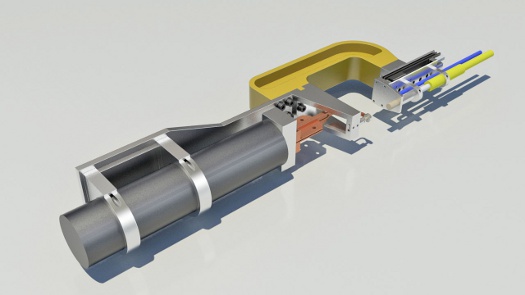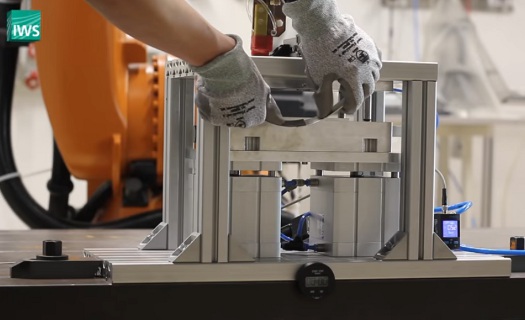 |
| February 26, 2019 | Volume 15 Issue 08 |
Designfax weekly eMagazine
Archives
Partners
Manufacturing Center
Product Spotlight
Modern Applications News
Metalworking Ideas For
Today's Job Shops
Tooling and Production
Strategies for large
metalworking plants
New joining gun system bonds metal and plastic in seconds

A new joining gun system bonds metal and plastic, creating a highly stable bond. [© Fraunhofer IWS]
Connecting plastics and metals poses a challenge because of the different physical properties of the two materials. All conventional joining options, such as bonds using adhesives or rivets, have their disadvantages. Adhesives need time to harden, which delays further processing. Plastics can be easily damaged during riveting. Furthermore, both adhesive bonding and riveting require additional materials, which increases production costs.
Scientists at the Fraunhofer Institute for Material and Beam Technology in Dresden, Germany, have developed a joining system that bonds metal and thermoplastic materials quickly. What's even better is that the modular gun has been designed so it can be integrated easily into many current production processes.
The system was recently demonstrated at the Hanover Trade Fair.
The new HeatPressCool-Integrative process (HPCI) is integrated into the joining gun, enabling direct and precise bonding between metal and plastic components quickly. During this process, the two materials are pressed together, and the metal at the bonding point is subjected to targeted inductive heat. This causes the thermoplastic material to partially melt, which in turn directly forms a firm bond with the metal as the plastic solidifies.

There is a catch, though, to the process. (There's always a catch!) But this one's not too bad or taxing. The Fraunhofer researchers pre-treat the metal with lasers to optimize the adhesion between metal and plastic to create anchoring structures.
"The special feature of this process is that we use laser ablation to drill relatively deeply into the metal, to a depth of up to a hundred micrometers, where the plastic can penetrate and then cool down, contract, and form a secure fit in this structure," says researcher Annett Klotzbach. "This generates a highly stable bond."
In order to integrate the joining gun into existing system technology in manufacturing operations, it has been designed with a modular structure. It can, for example, be mounted on a robot arm in place of a spot-welding gun. The joining gun can be applied wherever metal and plastics need to be precisely bonded, for instance in vehicle body construction in the automotive industry or for stainless steel panels in refrigerators or dishwashers.
Although the researchers have not provided test numbers for the bonding strength of the materials, they have provided a video of the main process (note, the pre-treatment is not specifically shown, but if you look real hard at the side of the tip of the metal piece being joined it looks like something has, indeed, been done to the surface). The Fraunhofer Institute has an excellent reputation for materials and process development.
What do you think?
Editor's Note: We plan to run an update on this story when we get even more details.
Source: Fraunhofer IWS
Published February 2019
Rate this article
View our terms of use and privacy policy
